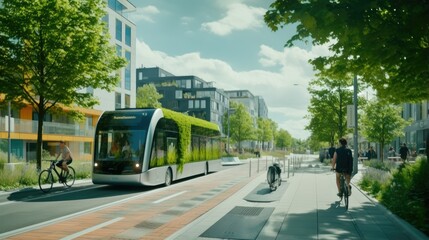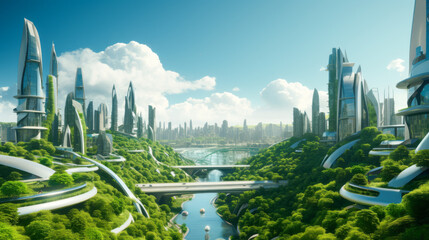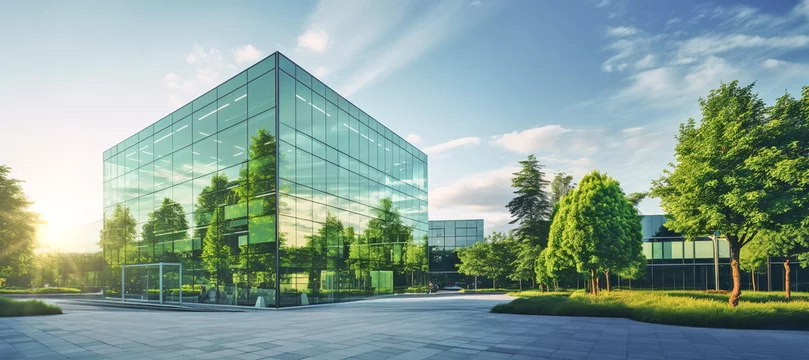Introduction
In recent years, the concept of creating sustainable and environmentally friendly urban spaces has gained popularity. The rapid growth of urban population and the ensuing demand for resources have put a strain on the environment. As a result, cities around the world are now seeking innovative solutions to reduce their environmental impact and promote sustainability. These green cities of tomorrow are being designed with a focus on reducing carbon emissions, promoting renewable energy, and creating green spaces for the well-being of citizens. In this essay, we will explore the various innovations in urban sustainability that are shaping the green cities of tomorrow.
Sustainable Transportation

One of the key components of a green city is sustainable transportation. Traditional modes of transportation, such as cars and buses, contribute significantly to air pollution and greenhouse gas emissions. In response, green cities are turning to innovative solutions such as electric vehicles, bike-sharing programs, and pedestrian-friendly infrastructure. Electric vehicles have gained popularity as a sustainable alternative to traditional cars, offering lower emissions and decreased reliance on fossil fuels. Bike-sharing programs have also become a staple in many green cities, providing citizens with an eco-friendly and healthy mode of transportation. Additionally, the creation of pedestrian-friendly infrastructure, such as walkable streets and bike lanes, encourages citizens to choose non-motorized modes of transportation, reducing traffic congestion and promoting air quality.
Renewable Energy
Another important aspect of green cities is the adoption of renewable energy sources. Traditional energy sources, such as coal and natural gas, contribute to air and water pollution, as well as greenhouse gas emissions. Green cities are increasingly turning to renewable energy sources, such as solar and wind power, to meet their energy needs. Solar panels are being integrated into the design of buildings, providing clean and sustainable energy. Wind turbines are also being utilized to harness the power of wind and generate electricity. By investing in renewable energy, green cities are reducing their dependence on fossil fuels and mitigating the impact of climate change.
Green Infrastructure

Green cities of tomorrow are also incorporating green infrastructure to improve the overall environmental quality of urban spaces. Green roofs, for example, are being installed on buildings to reduce the urban heat island effect and improve air quality. These roofs are covered with vegetation, which helps to absorb rainwater, reduce energy consumption, and provide habitat for wildlife. Additionally, green cities are creating urban forests and green spaces to promote biodiversity and provide residents with access to nature. Parks and public gardens not only improve the aesthetic appeal of cities but also provide health benefits and recreational opportunities for citizens.
Waste Management
Efficient waste management is another crucial aspect of urban sustainability. Green cities are implementing innovative waste management systems to reduce the amount of waste sent to landfills and promote recycling and composting. Advanced recycling programs are being developed to separate and process various types of waste, such as plastic, glass, and paper. Composting programs are also being introduced to divert organic waste from landfills and turn it into nutrient-rich soil for urban agriculture and landscaping. Furthermore, green cities are embracing the concept of a circular economy, where waste is seen as a valuable resource that can be reused, recycled, or repurposed to minimize environmental impact.
Smart Technology
Unleashing the Power of Smart Technology in Green Cities
The metamorphosis of green cities is being driven by the seamless integration of smart technology, ushering in an era where urban sustainability meets cutting-edge innovation. This technological evolution extends far beyond mere functionality; it’s a transformative force reshaping the very essence of how cities operate and thrive.
Smart Grids: Pioneering Energy Efficiency
At the forefront of this revolution are smart grids, the orchestrators of energy efficiency. These interconnected systems not only optimize energy consumption but also redefine the dynamics of power distribution. Picture a city where energy flows like a well-choreographed dance, responding dynamically to demand, minimizing waste, and maximizing the utilization of renewable resources. Smart grids lay the foundation for a more resilient and sustainable energy landscape.
Energy-Efficient Appliances: Redefining Consumption Patterns
Within homes and businesses, the integration of energy-efficient appliances acts as a catalyst for change. Imagine a cityscape where every device, from refrigerators to lighting systems, is designed not just for functionality but with a keen eye on sustainability. These appliances contribute to the broader goal of reducing carbon footprints, fostering a culture of conscious energy consumption among residents and businesses alike.
Intelligent Transportation Systems: Navigating a Greener Path
The bustling arteries of a city’s transportation system are being reimagined through intelligent transportation systems. Beyond mere convenience, these systems optimize traffic flow, reduce congestion, and enhance air quality. Picture a city where traffic jams are relics of the past, replaced by a seamless, interconnected network of smart vehicles and public transportation, contributing to cleaner air and more efficient travel.
Smart Sensors and Data Analytics: Illuminating the Path to Sustainability
In the heart of green cities, smart sensors and data analytics act as the watchful guardians of environmental health. These sensors, scattered throughout the urban landscape, collect real-time data on air quality, waste management, and resource usage. Through advanced analytics, city planners gain invaluable insights, enabling them to make informed decisions that resonate with the principles of sustainability. This dynamic approach to data-driven governance ensures that every step taken is strategic, fostering a city that adapts and evolves with its environmental demands.
The integration of smart technology is not just a superficial layer of convenience; it’s an intricate tapestry rewiring the very fabric of urban existence. Green cities are no longer a distant vision; they are the tangible reality shaped by the convergence of innovation and sustainability. As we traverse this landscape of technological marvels, we find ourselves in a city that not only breathes with nature but also thrives in harmony with the intelligent systems guiding its every move. Welcome to the future, where smart technology and green living intertwine to create a sustainable urban masterpiece.”
Conclusion
In conclusion, the green cities of tomorrow are shaping the future of urban sustainability through innovative solutions that prioritize the well-being of citizens and the environment. From sustainable transportation and renewable energy to green infrastructure and advanced waste management, these cities are setting a new standard for environmental responsibility and resilience. As the global population continues to urbanize, the development of green cities will be essential in addressing the challenges of climate change and resource depletion. By embracing innovation and collaboration, green cities are paving the way for a more sustainable and prosperous future.
